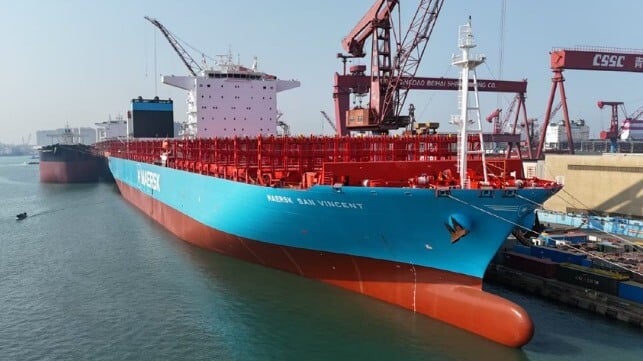Maersk Pursues Refits of Chartered Fleet to Reduce Costs and Emissions

Maersk reports it has passed the halfway mark on an ambitious program of refits designed to reduce fuel and operating costs as well as emissions for its fleet of chartered containerships. The carrier calls it a “win-win model” where it benefits from the improved economics of the vessel’s current operations, and the owners get the long-term value of a modernized vessel.
To date. Maersk reports working with its time-charter partners, more than 1,500 individual projects have been implemented across 200 vessels with 50 shipowners. An additional 1,000 projects are in process and scheduled to be finalized by 2027. The investment cost for the projects is split between Maersk and the vessel owners.
“Our medium- and long-term chartered fleet makes up a significant proportion of our operations as well as of our total fuel consumption,” explains Ahmed Hassan, Head of Asset Strategy and Strategic Partnerships at Maersk. “By working closely with our partners, we aim to implement solutions that not only reduce emissions but also enhance the overall competitiveness of our fleet.”
More than half the vessels operated currently by Maersk are on charter, according to data from Alphaliner. The company has a total of 736 containers, of which 392are chartered.
Maersk explains that many of the vessels were designed to operate at faster speeds than the industry maintains today. Also, developments have permitted some ships to increase the rated capacity for containers.
Among the projects being carried out are significant changes to the vessel configuration with the replacement of the propeller or bulbous bow from the original designs for higher speeds. Maersk says the integration of an optimally designed bulbous bow reshapes water flow around the hull to reduce drag and enhance hydrodynamic efficiency. The propeller replacement is combined with Pre-Swirl Devices that assist in maximizing thrust while minimizing energy loss.
Other retrofit projects include elements such as auxiliary engine waste heat recovery systems that allow steam production from auxiliary engine heat, reducing the reliance on fuel-oil-fired boilers. Similarly, the installation of shaft generator systems cuts down auxiliary engine usage.
Cargo-carrying capacity is being enhanced through a range of structural and technical improvements. This can include elevating the wheelhouse to improve line of sight and increase intake, raising the lashing bridges, strengthening the vessel’s deadweight capacity for deeper drafts, or upgrading both lashing systems and loading computer functionalities.
The projects are part of Maersk’s overall goal to reduce absolute scope 1 greenhouse gas emissions by 35 percent by 2030, compared to the 2022 baseline. Last year, the company reported it would be building new vessels as a replacement for some of the oldest ships in its fleet, as well as the adoption of alternative fuels for newbuilds.
Maersk also undertook the first conversion to dual-fuel methanol capabilities of a large containership. The project for the conversion of the Maersk Halifax was completed in 2024, and also included a nearly five percent increase in container capacity. The company has said it would explore the conversion of sister ships from this 15,000 TEU class.
Hapag-Lloyd, working with vessel owner Seaspan, announced a similar program to refit up to 60 of the Seaspan-owned containerships. The program was designed to prepare the vessels for methanol fuel operations. It has also been changing propellers on its owned fleet and other adjustment to improve operating efficiency.
